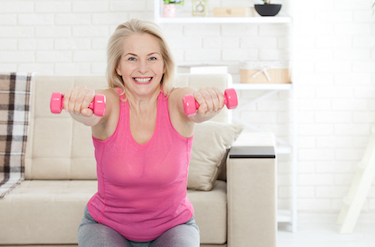
Strength Training for Older Adults
- Posted on:
- Posted in: Health
Strength training can be especially important for older adults because we can loose three-to-five percent of our muscle mass each year after about age 30. At Puget Sound Orthopaedics, we’re big believers in the power of muscle building through strength training.
Our sports medicine doctors and team of physician assistants work with you to treat an array of musculoskeletal disorders. We’re here to ensure you regain function as quickly as possible.
For our older adults who want to return to an active, independent life, it’s important to focus on rebuilding muscle strength. The scientists and health professional at the Centers for Disease Control (CDC) and Tufts University find this so important that they developed an exercise protocol to address the need. Their short booklet, Growing Stronger: Strength Training in Older Adults presents a program that can make a profound difference in your physical, mental, and emotional health.
Why strength training?
Strength training may give you the image of heavily muscled men pumping iron at the gym. The reality is strength training can be accomplished without weights in the comfort of your own home. You won’t bulk up. Rather you’ll regain some muscle from your younger days. The benefits of strength exercises two or three times a week are well-documented:
- Prevent chronic diseases like arthritis and osteoporosis
- Improve glycemic control for diabetics
- Build strength in all major muscle groups
- Maintain bone density
- Improve balance, coordination, and mobility
- Boost metabolism by as much as 15%
- Reduce the risk of falling
- Maintain independence in performing activities of daily life
The beauty of a strength training program for adults over 40 is that you don’t need to buy equipment. A sturdy chair, good shoes, comfortable clothes, and time are all you need. You can add dumbbells and ankle weights as you get stronger. You can also switch up the routine and add new exercises.
Growing Stronger is a three-part program. First, Part I strengthens your body slowly using only body weight. Next, Part II introduces weights to increase strength. Finally, Part III adds variety to boost strength even more. The exercises are designed to “strengthen all of the major muscle groups in the upper and lower body. They also target muscles affected by osteoarthritis, particularly in the shoulders, hands, hips, and knees.”
We suggest downloading the PDF booklet in full at Growing Stronger: Strength Training for Older Adults. There you will find tips, checklists and worksheets that illustrate each of the exercises, and also include:
- Using visualizations to build self-confidence
- Ways to celebrate your success
- How fit and strong are you now checklist
- Goal-setting worksheets
- Exercise intensity indicator
- Staying on Track: A 12-week workbook
The First Set of Strength Training Exercises
Growing Stronger: Strength Training for Older Adults is an extremely comprehensive program. For now, we’re sharing the first set of strength exercises to help you start.
First, warm up with a 5-minute walk. If it’s rainy you can do this in your home. Mix in some stair steps if your home has stairs.
Then, for each of the following, repeat the exercise ten times. Rest for one minute. Then, repeat it ten more times. You’ll complete two rounds of circuit training with this strength training program.
Squats
Squats make walking, jogging, and climbing stairs easier.
- Stand in front of a sturdy chair. Your feet should be slightly more than shoulder-width apart. Extend your arms straight in front of you.
- Place your weight on your heels. Bend your knees as you lower yourself towards the chair in a slow, controlled motion. Count to 4.
- Then, slowly rise back up to a standing position as you count to 2.
Wall Push-Ups
Easier than a push-up, this strengthens arms, shoulders and chest.
- Stand a little farther than arm’s length from a wall. Face the wall, lean your body forward and place your palms flat against the wall at shoulder height and shoulder-width apart.
- Bend your elbows as you lower your upper body toward the wall in a controlled motion as you count to 4. Keep your feet planted.
- Then, slowly push yourself back until your arms are straight. Count to 4. Make
Toe Stands
Strengthens calves and ankles to restore stability and balance.
- Stand with your feet shoulder-width apart. Use a nearby chair or counter for balance.
- Slowly push up as far as you can onto the balls of your feet. Count to 4. Hold for 2 to 4 seconds.
- Slowly lower your heels back to the floor as you count to 4.
Cool down by stretching.
If the weather is nice try doing these exercises outside. It’s a great way to get fresh air and Vitamin D.
Starting on the path to regaining your strength is simple and easy. Before you start any exercise program please talk with your doctor.
SHARE


